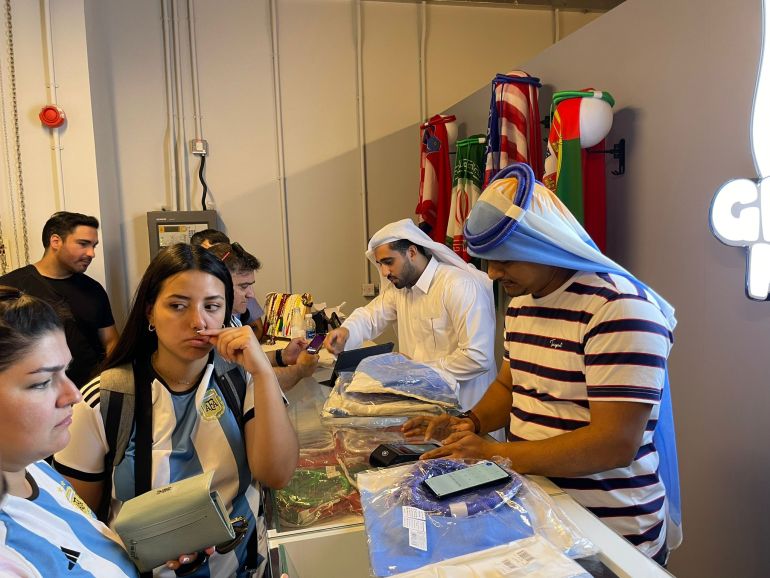Doha, Qatar – In 2002, football enthusiasts visiting Japan and South Korea for the World Cup became acquainted with the hand fans.
Eight years later, vuvuzelas were introduced to the world by South Africa.
This year, Qatari national Khalifa Naimi is hoping to put a new spin on the traditional head scarf, the ghutra, for a major impact on football fans descending onto his home turf for the 2022 World Cup.
On most days, the 26-year-old is hustling most days at his “Ghutra Mundo” store tucked away in a corner of the Souq Waqif Metro Station in the capital Doha.
Business is booming as millions of fans from across the world troop to the Gulf country for the first tournament to be hosted in the Middle East. Some of the scarves from his store and others, have even begun to show up at the stadiums during matches.
But for Naimi, sales are just one aspect of the job. His main focus is now educating football fans about a culture he is incredibly proud of, he says.
“The ghutra is a great unifying symbol that is part of our national dress”, Naimi tells Al Jazeera. “To teach the world and show that Qataris are welcoming and to partake and share in our culture makes the ghutra a great symbol of hospitality”.
All flags of the 32 qualifying teams for the World Cup have been infused on the ghutra. Naimi also provides bespoke thobes (traditional ankle-length robe) and prayer beads.

‘Part of our persona’
Products infused with regional identity can sometimes be a tough sell to some who may view it as trivialising the culture, Naimi said.
But he says he has received mostly positive feedback from locals and fans alike, even if he is aware of an continuing debate between conservative and progressive elements of his community.
“What we are trying to do is something to help Qatar and the Arab region in a positive manner,” he said.
As customers quickly congregate ahead of a football match at the storefront, Naimi makes sure to personalise their experience, explaining the modest outfits of both men and women in the region.
He shows off different ways of wearing the ghutra, especially his go-to style – the “cobra”.
This interaction with global football fans to put them at ease about wearing the ghutra is important he says, because of a fine line between cultural appreciation and cultural appropriation.
“I’m hoping my product brings joy and educates people on the Qatari and the Arab culture as a whole,” Naimi said. “This is not just a Qatari thing, it’s in Saudi Arabia, the UAE, Bahrain, Kuwait and around the Middle East. it’s part of our persona. I want people to come for the Word Cup and leave with our culture.”
For many customers, including Jouad from Morocco, this is their first dip into Qatari culture. “I never tried the Qatari culture, this is the first time I have tried it and I have lived in Qatar for 10 years,” says Jouad from Morocco. “When you see the Moroccan team and people here you feel proud, especially on Arabic land here for the first time. I feel like I am home, in the capital of Morocco”

Ashraf, a resident of Singapore, a proud owner of a ghutra with Brazilian colours, says one cannot really get the full World Cup experience without rocking the scarf. “[It’s] just like if you go to Brazil, you wear all the nice Rio Carnival stuff … it amplifies the culture,” he said.
Tunisian fan Belgacem agreed, trying on a ghutra as his wife took photos, smiling.
“I am buying it [the ghutra] as a souvenir,” he said. “When I go back to my country, I will remember this marvellous event and I will celebrate my presence here.”
With the tournament now in full swing, Naimi is proud of his task and beaming with patriotic pride, even if he is missing live games during the tournament.
“It means the world to host this tournament in Qatar,” he told Al Jazeera. “This is the time we show the world how we shine. Qatar may be small in size, but it is big in acts, and hopefully, this tournament shows that.”


